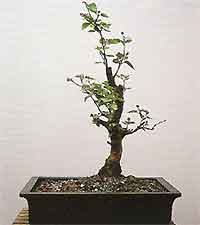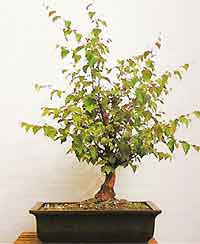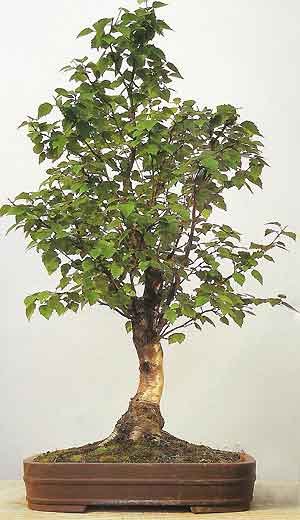Bonsai Trees
Case Histories
Silver Birch - (betula pendula)
Silver Birch Bonsai Style: Informal Upright

Land containing many silver birch trees was being cleared and I was fortunate enough to obtain permission to collect any trees that I desired. It was late winter and I arrived at the site well prepared with several plastic sacks, trowel, knife, hand saw, secateurs and damp newspaper.
There were many silver birch, but most of them were mere seedlings and not what I had hoped for. Nevertheless, being highly suitable for a small group planting that I had in mind, I collected about thirty or so and was amazed at how far the roots on these small trees had spread.
They were very shallow and therefore easy to remove from the stony ground. The roots were long, with only small amounts of fibrous root at the very ends.

Root pruning would make the root system far more efficient and compact, reducing the length of these unnecessarily long roots and encouraging the fibrous roots to emerge much closer to the trunk.
Spotting a large silver birch growing on a grassy bank, I went to investigate. It clearly had possibilities and with some judicious pruning, a well shaped, tapering trunk could be created. Several major branches that were clearly not required were pruned off and I easily dug the tree up. After the roots had been carefully wrapped in damp newspaper I placed it in a plastic bag for further protection.
I was delighted that I had collected such a good specimen, far better than I had hoped for and I started walking back to my car, taking a different route just in case I noticed anything else interesting on the way. What a good plan that turned out to be, for I did spot another tree with potential, this time a downy birch. It was a very strange tree that had been naturally dwarfed by nibbling wildlife, and consequently had a thick trunk, full of character. When digging up this tree, I had to cut some very long roots which had spread several metres and few fibrous roots existed. I set off for home, pleased with my morning's work.
Silver Birch Bonsai History: Training

This birch had the better root system and so I planted it in a very large and deep rectangular bonsai pot to recover and establish. It was positioned in a sunny area of the garden to encourage budding and that spring, many new shoots duly appeared. These were allowed to extend while the tree gained strength.
By mid summer the tree was growing very strongly and so I thought it prudent to remove growth that was definitely not required, so that more energy could be channeled into the remaining branches. All shoots were wired into shape as it was easiest to do this while they were still young and flexible.
Silver birch have many qualities in bonsai training, including attractive bark, small leaves and good autumn colour, but on the downside they are prone to die back and often shed branches for no particular reason. This did not deter me as I planned to create a tree with many branches that would not be spoilt if some died over the years. The young branches were wired and they set in place within a matter of weeks. I then removed the wire as it was beginning to bite in. The tree was regularly fed and grew well for the remainder of the year. That winter I wired all of the new shoots and although it was still early days for the silver birch, it was starting to look quite natural. The tree remained in this pot for a further year, where it was lightly pruned in the summer.
When spring arrived I removed the silver birch from its pot and was pleased to find that the roots were in good order. The tree was root pruned, allowing it to be planted in a slightly over-large rectangular pot that I had recently purchased as I liked it so much - a very good reason for buying a pot! Being a light beige colour it matched areas of the trunk colour and was useful to establish a shallower root system. Before it leafed out the tree was further wired, pruned and shaped. When pruned in the spring birch do have a tendency to bleed. This is certainly reduced if they are root pruned at the same time, but although alarming the bleeding not detrimental to the tree. Sap for birch wine is actually siphoned directly from the tree's trunk in spring, causing no harm.
After two years in this pot it was planted into a smaller rectangular pot and the tree looked far better for not being over potted. By this time the colour of the bark was beginning to become much more silver and now that the main branches were in position I started to develop the side branches. These were wired outwards to give the tree much needed width and a very natural looking bonsai emerged.
 Land containing many silver birch trees was being cleared and I was fortunate enough to obtain permission to collect any trees that I desired. It was late winter and I arrived at the site well prepared with several plastic sacks, trowel, knife, hand saw, secateurs and damp newspaper.
Land containing many silver birch trees was being cleared and I was fortunate enough to obtain permission to collect any trees that I desired. It was late winter and I arrived at the site well prepared with several plastic sacks, trowel, knife, hand saw, secateurs and damp newspaper. Root pruning would make the root system far more efficient and compact, reducing the length of these unnecessarily long roots and encouraging the fibrous roots to emerge much closer to the trunk.
Root pruning would make the root system far more efficient and compact, reducing the length of these unnecessarily long roots and encouraging the fibrous roots to emerge much closer to the trunk. This birch had the better root system and so I planted it in a very large and deep rectangular bonsai pot to recover and establish. It was positioned in a sunny area of the garden to encourage budding and that spring, many new shoots duly appeared. These were allowed to extend while the tree gained strength.
This birch had the better root system and so I planted it in a very large and deep rectangular bonsai pot to recover and establish. It was positioned in a sunny area of the garden to encourage budding and that spring, many new shoots duly appeared. These were allowed to extend while the tree gained strength.